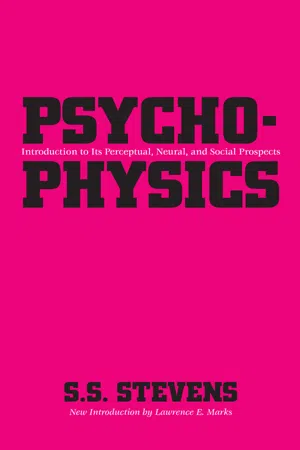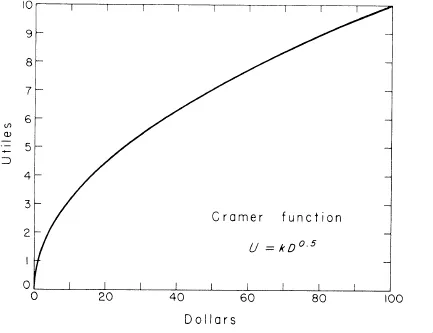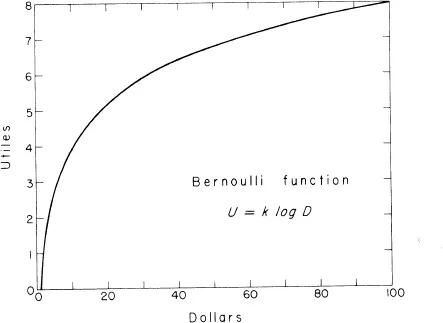CHAPTER 1
The
Psychophysical
Law
It has taken some homely and simple procedures to reveal beautiful and elegant relations in the behavior of the sensory system. Recently invented procedures have shown that whenever the stimulus increases, the intensity of the sensation grows in accordance with a common basic principle. In every sense modality, sensation is a power function of stimulus. The principle seems clear and straightforward now, but it was a zigzag path with many wrong forks that led finally to the discovery that equal stimulus ratios produce equal sensation ratios. That is the basic principle that underlies the psychophysical law. The ratio invariance tells us that the psychophysical law is a power function.
It is not easy, after the fact, to single out exactly those blocks and diversions that deflected progress, my own included, from a straight course toward the psychophysical law, for experience has meaning only against the background of the Zeitgeist, which permeates our thinking and determines what, in any given time period, is in fact thinkable. I find that I can think now about quantitative relations among sensations that were scarcely conceivable four decades ago—relations that were deemed quite beyond imagining a hundred years ago. Barriers of belief had to be breached in order to forge a fresh paradigm.
It was not only that laboratory traditions were encrusted with rules and procedures that blocked the way, but before it became possible to think more clearly about the measurement of sensation, the nature and meaning of measurement had to be understood in a revised light. What by common consent was unmeasurable a century ago has now been measured, and in the process there has emerged a restructuring of psychophysics that provides a new perspective on the ancient problem of the relation of stimulus to sensation. Many features of the new psychophysics have evolved so gradually that to me much of the progress seemed more like an onward flow than a sudden leap. But then, the Zeitgeist changes only slowly. It takes a generation for a new conception to win its place in the textbooks.
A contrary Zeitgeist was not the only impediment, however. Another hazard arose from the natural tendency of scientists to find fascination in complexity. Simplicity is easy to overlook. The history of both mathematics and science has taught us repeatedly that it is often most difficult to discover the simplest things. Before the theory of measurement could support a new psychophysics, some far-reaching simplifications had to be introduced both at the conceptual level and at the level of method and procedure.
TWO CONFLICTING LAWS
Psychophysics may be said to have been born when scientists began to think seriously about the possibility that they might measure sensation. That was back in the 1850’s. Long before then, however, many people had marveled at the richness of sensory experience and had described how sensations differ in quality. Seeing is different from hearing; taste is different from touch; pain is different from smell. But each of those sensations can also vary in intensity or degree, so that a sensation of brightness may be said to be weak or strong. But how weak, or how strong? Is it possible to measure the strength or magnitude of a sensation, or is sensation too personal and too intimately an affair of the mind to be quantified?
Most scientists who addressed that question decided that no direct measurement could be made of a subjective magnitude. A few scientists conceded that some kind of indirect measurement might prove possible, but the possibility of any direct kind of measurement was ruled out as patently absurd. As it turned out, however, a simple and direct kind of measurement was later invented and put to interesting uses. Yet for almost a century psychophysics tried to solve its central problem—the measurement of sensation—by indirect methods, methods that inspired great ingenuity but that proved inadequate to the task.
The development of the direct methods has changed many things. It has made possible the quantification not only of sensory magnitudes, but also of other interesting matters concerned with human judgments. Opinions about the prestige of different occupations and the seriousness of different crimes provide two examples of the kinds of subjective opinions that have been scaled by the direct methods of psychophysical measurement. The direct quantification of the social consensus has inaugurated serious explorations in what we might call social psychophysics.
More important to psychophysics itself, the new direct methods resolved a conflict that had flared off and on for more than two centuries. The issue concerns the form of the psychophysical law, the equation that tells how the strength of the external stimulus determines your impression of subjective intensity. The two contending laws are known as the logarithmic law and the power law.
Curiously enough, the two conflicting laws made their first appearance in connection with a friendly game of chance. More than two centuries ago a paradox in a gambling game led to one of the first conjectures about the law that governs the subjective value of stimuli. If we regard money as a stimulus and the subjective value attached to its ownership as a response, then the problem becomes a stimulus-response relation. How does subjective value grow when the number of dollars is increased? What is the mathematical form of the law? That is the basic question, but first let us turn to the gambling problem.
TWO LAWS OF UTILITY
Imagine for a moment that we decide to play an old and famous game named after St. Petersburg. You are to flip a coin as often as necessary until it comes up heads. If it comes up tails only once, you pay me a penny. If it falls tails twice, you pay me 2 pennies, if three times, you pay 4 pennies, and so on—doubling your payment for each appearance of tails. Now, in order for me to persuade you to play the St. Petersburg game, you would want me to pay you something. How much? For what stake would you be willing to play? Ten pennies? Twenty pennies? Many people have been willing to take the risk of playing the game for amounts such as those.
But if the coin came up tails time after time, as indeed it might, the payment you owed me would double each time. If it came up tails eleven times in succession, you would owe me 1024 pennies, and if the coin continued to come up tails your debt could reach an enormous amount. Therein lies the paradox. Why would anyone risk a potentially enormous loss for a relatively small gain?
In the year 1728 a 24-year-old mathematician named Gabriel Cramer puzzled over the paradox and hit on a possible solution. Let us suppose, he said, that the subjective value of money, what economists now call utility, grows less rapidly than the numerical amount of money, the number of pennies or dollars. In particular, let us suppose that the subjective or psychological value grows only as the square root of the number of pennies. A square-root relation would mean, for example, that in order for the satisfaction you felt to double, I would need to give you four times as many pennies. Given such a nonlinear relation between the money stimulus and the mental appreciation of it, we would have, thought Cramer, a possible explanation of the St. Petersburg paradox. Risking 90 pennies, says the square-root relation, is not nine times as bad as risking 10 pennies, it is only three times as bad, for the square root of nine is three.
We know about Cramer’s conjecture only because Daniel Bernoulli, another noted mathematician, mentioned the idea in a footnote attached to his famous paper of 1738 in which he proposed his own solution to the paradox. Bernoulli’s hypothesis, which he reached quite independently, resembled Cramer’s in one important respect. Both men concluded that the subjective value of each penny becomes less as the number of pennies increases. In the jargon of the economist, money exhibits a decreasing marginal utility.
But Bernoulli chose a logarithmic function to represent the decreasing marginal utility, whereas Cramer had chosen a power function with an exponent of one-half, which is the square root. In Fig. 1 we see a graph of the power function that Cramer used to explain the growth of utility (ordinate) as a function of gains in wealth (abscissa). A graph of the logarithmic function proposed by Bernoulli is shown in Fig. 2. Both curves are similar in one important respect. They are both concave downward in a manner consistent with the principle that has appeared so obvious to nearly everyone, namely, that the value of one added dollar seems less when you have a thousand than when you have only two or three. Nevertheless, there are important differences between the two functions, even though both are concave downward.
Fig. 1.The form of the power function proposed by Cramer in 1728 to express the relation between subjective value (utility in utiles) and amount of money. The exponent is 0.5, which means that the function expresses a simple square-root function. In other words, the subjective value grows as the square root of the number of dollars, so that it takes a fourfold increase in dollars to double the subjective value. (From Stevens 1959a. Reprinted by permission of John Wiley & Sons, Inc.)
Fig. 2.A logarithmic function of the kind Bernoulli proposed in 1738. It was supposed to express the relation between subjective value in utiles and number of dollars. (After Bernoulli 1738.)
Bernoulli derived his logarithmic function by first making a simple assumption. The added utility, he said, grows smaller as the number of dollars grows larger—a simple inverse relation. Cramer’s power function derives from an assumption that is just as simple and perhaps even more plausible. This alternative assumption states that the added utility grows smaller as the total utility grows larger. Again a simple inverse relation, but this time it is between the added utility and the total utility, not between the added utility and the total number of dollars.
Which alternative provides the better formulation? Bernoulli’s logarithmic function has commanded the greater attention and has exerted the wider influence. “To this day,” wrote one commentator, “no other function has been suggested as a better prototype for Everyman’s utility function” (Savage 1954). Perhaps that author had overlooked Cramer’s power function—easy to overlook—for it was written in Latin and appended as a note to Bernoulli’s original article. In any case, Cramer’s idea has exerted almost no influence among those who theorize about utility. But experiment, not assumption, can settle such issues, and experiments have suggested that Cramer was the one who diagnosed the matter correctly.
The correctness of Cramer’s power function can be demonstrated by experiment. A simple one that I have often carried out with students in a classroom follows a procedure suggested by experiments in sensory psy-chophysics (Galanter 1962). The student is asked to attempt his own subjective estimate of utility in answer to a proposal like this: “Suppose I were to tell you that I have a special fund for the purpose, and that I am going to give you $10. That would make you happy, would it not? Now think this over carefully: how much would I have to give you to make you twice as happy?”
The results of such experiments support a crucial point. A 2-to-l change in the anticipated satisfaction, or utility, is typically estimated to require a change in the size of the gift by a factor of about 4. In other words, it requires about $40 to double the utility of $10, which is what Cramer’s conjecture predicts. Classes of students have given factors ranging from about 3.5 to 5 (Galanter 1962). Those are average or median values, of course, for people do not always agree with one another in their estimates. But the interesting point is that by a procedure of direct estimation, a group of people give median estimates of “value” that grow approximately as the square root of the number of dollars. The students in those experiments have confirmed Cramer’s conjecture of 1728—the one illustrated graphically in Fig. 1.
Let us turn now to the indirect psychophysical procedures invented in the 1850’s. There we encounter the second round in the contest between the logarithmic law and the power law.
PLATEAU’S PARTITION SCALE
In a field very different from games of chance, that of visual perception, the blind Belgian physicist J. A. F. Plateau undertook to determine how the subjective lightness of a surface changes with stimulus intensity (the reflectance of the surface). We have no evidence that Plateau knew about Cramer’s conjecture, or that he conceived his perceptual problem to be in any way similar. Whatever the circumstances, we know that Plateau went beyond mere conjecture and conducted an experiment. The clear lines of his thought, however, became snagged on a misconception.
Plateau took it for granted that, as he said, “we have no ability to judge directly the ratio of two sensations.” Having made that assumption, he found himself looking perforce for an indirect approach. If we cannot judge when one sensation is twice as intense as another, said Plateau, perhaps we can at least judge when the contrast between pairs of reflecting surfaces appears equal. If we could create equal contrast steps of lightness, perhaps we could build up a lightness scale starting from zero. That procedure, he reasoned, would provide an indirect measurement of sensation.
Plateau devised an ingenious procedure. He gave each of eight artists a black and a white and asked each of them to paint a gray that appeared to lie halfway between black and white. Remarkably enough, although each painter worked in his own studio, each presumably under very different illumination, the grays they painted turned out to look very much alike, “presque identiques.” From that remarkable fact—the invariance of the bisection point under changing illumination—plus the assumption that the bisection point corresponded to a sensation ratio rather than to a sensation difference, Plateau concluded that apparent lightness grows as a power function of the light intensity given off by the reflecting surface. Actually, since the logarithmic law also predicts an invariant bisection point, Plateau’s experimental finding would not preclude a logarithmic law unless more was known. Of course, Plateau may have known more. He may also have measured the actual reflectance of the paintings.
In any case, Plateau knew that more experiments were needed to determine additional contrast steps between black and white, so he asked his friend Delboeuf to carry on the study by mixing black and white to produce shades of gray on rotating color wheels. In a long and tedious effort, D...


